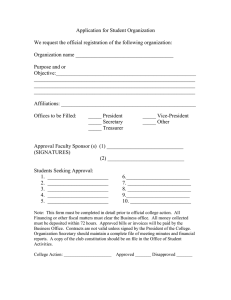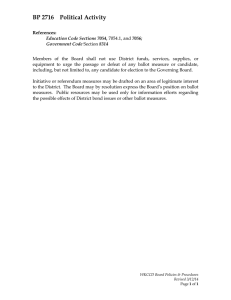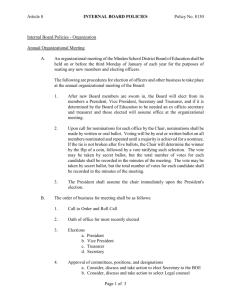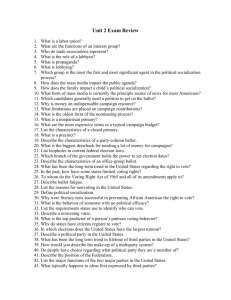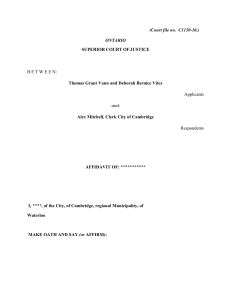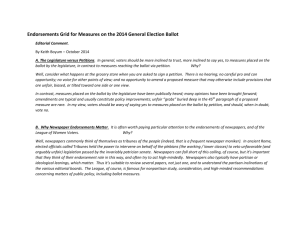Mississippi's Initiative and Referendum: A Primer Foreword
advertisement
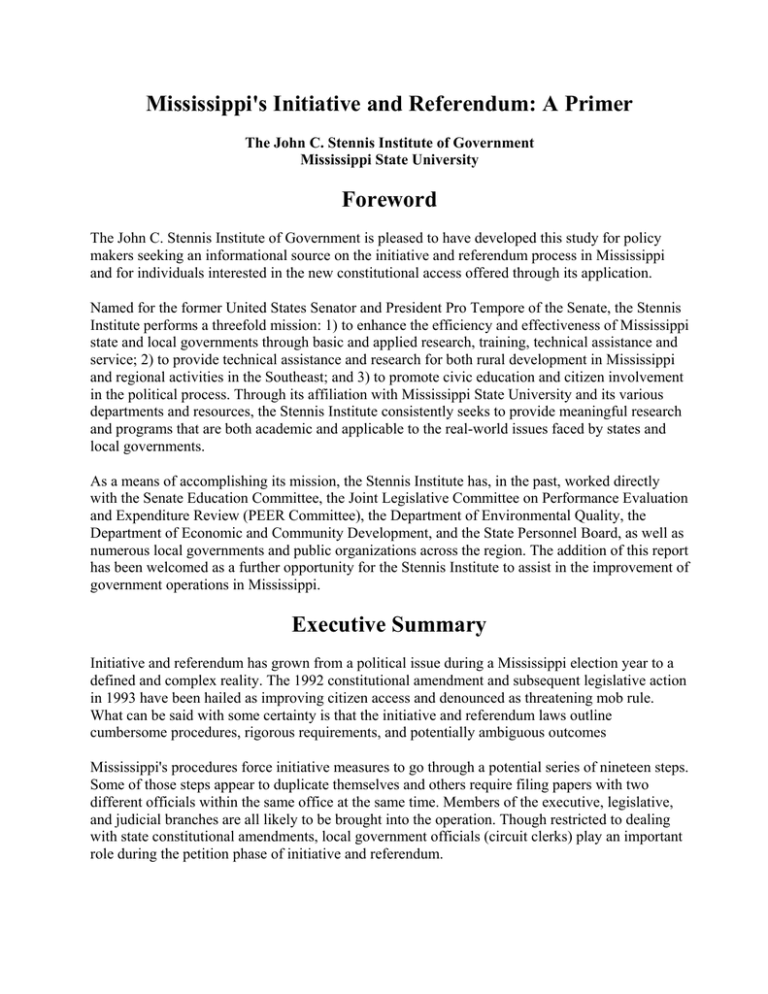
Mississippi's Initiative and Referendum: A Primer The John C. Stennis Institute of Government Mississippi State University Foreword The John C. Stennis Institute of Government is pleased to have developed this study for policy makers seeking an informational source on the initiative and referendum process in Mississippi and for individuals interested in the new constitutional access offered through its application. Named for the former United States Senator and President Pro Tempore of the Senate, the Stennis Institute performs a threefold mission: 1) to enhance the efficiency and effectiveness of Mississippi state and local governments through basic and applied research, training, technical assistance and service; 2) to provide technical assistance and research for both rural development in Mississippi and regional activities in the Southeast; and 3) to promote civic education and citizen involvement in the political process. Through its affiliation with Mississippi State University and its various departments and resources, the Stennis Institute consistently seeks to provide meaningful research and programs that are both academic and applicable to the real-world issues faced by states and local governments. As a means of accomplishing its mission, the Stennis Institute has, in the past, worked directly with the Senate Education Committee, the Joint Legislative Committee on Performance Evaluation and Expenditure Review (PEER Committee), the Department of Environmental Quality, the Department of Economic and Community Development, and the State Personnel Board, as well as numerous local governments and public organizations across the region. The addition of this report has been welcomed as a further opportunity for the Stennis Institute to assist in the improvement of government operations in Mississippi. Executive Summary Initiative and referendum has grown from a political issue during a Mississippi election year to a defined and complex reality. The 1992 constitutional amendment and subsequent legislative action in 1993 have been hailed as improving citizen access and denounced as threatening mob rule. What can be said with some certainty is that the initiative and referendum laws outline cumbersome procedures, rigorous requirements, and potentially ambiguous outcomes Mississippi's procedures force initiative measures to go through a potential series of nineteen steps. Some of those steps appear to duplicate themselves and others require filing papers with two different officials within the same office at the same time. Members of the executive, legislative, and judicial branches are all likely to be brought into the operation. Though restricted to dealing with state constitutional amendments, local government officials (circuit clerks) play an important role during the petition phase of initiative and referendum. The system itself is not the only complication, however. Mississippi has the second highest siture threshold for initiated constitutional amendments in the nation, a geographic distribution requirement more difficult to meet than any other state, and a "super-majority" voting requirement of an unprecedented level. Additionally, various options could be placed on the ballot as separate measures or as two parts of the same issue. The election can have any one of four (4) conclusions, only one of which is passage of the original initiative measure. Failure of a measure was thought to mean the end of the efforts for at least two years. However, the language of the enabling statutes calls this into question due to failure without being "rejected by a majority of the qualified electors voting thereon." A number of initiative proposals have been filed with the Secretary of State and attempted to navigate through this maelstrom. One, commonly referred to as the "term limits initiative," has surmounted every hurdle up to placement on the ballot. This is scheduled to go before the electorate in November of this year. Others have gotten stalled at different points along the way. It is hoped that this report will enable public officials and citizens to develop a better understanding of the enigmatic and intricate privilege placed in the hands of the Mississippi electorate. The History and Meaning of "Initiative and Referendum" in Mississippi Initiative and referendum became a popular political subject during the last state election year in Mississippi. Efforts to increase citizen participation in the policy molding process revived a debate dating back to 1914. An amendment in that year allowed for direct citizen initiatives and was later ruled unconstitutional based on procedural arguments. A statewide referendum on a proposed constitutional amendment to once again allow citizen initiatives was defeated by the electorate in 1989 and resubmitted in more specific form in 1992. During the interim, citizen initiative and referendum (I&R) was discussed as a potential solution to many of the so-called ills in the 1890 State Constitution. The Constitution of 1890 survived a number of study commissions and unofficial calls for constitutional conventions, relying instead on slow, piecemeal revisions on a more-or-less annual basis (Hatcher, 1993). With the passage of the 1992 amendment, the Mississippi Legislature was directed to provide procedures and enact laws governing the I&R process in Mississippi. Many of the subsequent regulations were already established by the 1992 amendment, requiring only codification by the Legislature. Included among those issues were: the prohibition against using I&R for anything other than constitutional amendments, the criteria for the number of signatures based on votes cast in the last state general election, a mandated geographic balance on petitions the requirement of a majority vote equal to at least 40 percent all votes cast in the election for passage of an initiative, and the directive that all initiative measures must first be submitted to the Legislature for consideration and action prior to the referendum. The latter constitutional provision would seem to indicate that Mississippi has an indirect citizen initiative process. In reality, Mississippi's law makes use of both indirect and direct initiative. Direct initiative avoids the legislative process by placing measures directly on the ballot after meeting specified qualifications (Zimmerman, 1986). Indirect initiative acknowledges the legislative role in policy making by submitting measures to the legislature for action. If the legislature fails to act within a specified time frame, the measure is then placed on the ballot for popular vote (Zimmerman, 1986). The hybrid used in Mississippi requires all I&R measures that meet the qualifications to be submitted to the Legislature and placed on the ballot in their original language. If the Legislature considers and amends a measure, the modified version is also placed on the ballot as a separate measure. If the measure is rejected completely and an alternate measure proposed by the Legislature, the two measures are tied together on the ballot in a confusing way that allows for multiple voting options by the electorate, as will be described. The vote itself is the referendum portion of initiative and referendum. There are generally three types of referenda in the United States. The first is constitutionally required on certain issues (such as amendments to the Constitution of 1890 in Mississippi). The second allows for the legislative body to voluntarily submit a matter to popular vote before enactment. And the third is by citizen petition requiring a popular vote before a proposition passed by the legislature is enacted (Book of the States 1988-89). Basic qualifications for Mississippi I&R proposals are not entirely unusual when compared with other states allowing for citizen initiatives on constitutional amendments. Most states require a minimum number of signatures on a petition, ranging from a low of 3 percent (Massachusetts) to a high of 15 percent (Arizona and Oklahoma) of votes cast in the last gubernatorial election. Many states also employ a geographic requirement on signatures in order to assure that no one region can dominate the process. For example, Nevada's 10 percent signature threshold includes a requirement that at least 10 percent of the signatures come from each of 75 percent of the counties (Breaux and Company, 1991). While more demanding, Mississippi's additional requirement that a majority vote for a measure also represent a minimum of 40 percent of the votes cast in the overall election is not without precedent. Massachusetts requires that, for passage, a majority in favor of an initiative proposal must be equal to 30 percent of the total votes cast in an election while Nebraska's laws insist on a majority vote equal to 35 percent look of the States 1990-91 Mississippi I&R Laws and Procedures With the passage of Senate Concurrent Resolution No. 516 (General Laws of the State of Mississippi, 1992, Chapter 715) and its subsequent approval by the electorate on November 3, 1992, Section 273 of the Mississippi Constitution of 1890 was amended to allow for constitutional amendments by citizen initiative and referendum. During the 1993 Legislative Session, the House and Senate passed enabling legislation governing the I&R process as required by the newly amended Constitution (General Laws, 1993, Chapter 514). Those regulations were codified as sections 23-17-1 et seq. Mississippi Code Annotated of 19721. The sections provide procedures for formulating and submitting initiative measures, the collection and certification of signatures on petitions, actions by state officials and the legislature, ballot placement, campaign regulations, and voting requirements for passage. In so doing, the Legislature succeeded in involving all branches of government (legislative, executive, and judicial), and all circuit clerks, as well as the citizens intending to use I&R as a means for influencing the policy making process. Additionally, campaign regulations were strengthened to the point that campaigning for or against an initiative measure became more controlled than campaigning for a candidate. Taken as a whole, the new law produced one of the most difficult processes for amending a state constitution through citizen initiative found anywhere in the country. PREPARING AN INITIATIVE PROPOSAL The process begins with a citizen sponsor submitting a proposed initiative to the Secretary of State who then sends a copy to the Revisor of State Statutes, a member of the Attorney General's staff. The proposed initiative must include, within the text of the initiative, "the amount and source of revenue required to implement the initiative [and] [i]f the initiative requires a reduction in any source of government revenue, or a reallocation of funding from currently funded programs,... the program or programs whose funding must be reduced or eliminated to implement the initiative" (Section 273(4), Mississippi Constitution of 1890 and §23-17-1(3), Mississippi Code Annotated of 1972). Within ten (10) working days of receiving the proposal, the Revisor of Statutes reviews it, makes suggestions on style and form, and can recommend changes in substance. During this time, the Revisor can discuss these suggestions and recommendations with the proposal's sponsor but the sponsor reserves the right to disregard or accept any and all such advice. Once completed, the Revisor of Statutes must issue a certificate of review indicating his or her actions and whether the sponsor accepted or refused the counsel.(§23-17-5 MCA 1972). Once the Revisor of Statutes has issued the certificate of review, the sponsor has fifteen (15) days to again file the proposal and the certificate with the Secretary of State, who then assigns a serial number to the proposal and submits a certified copy to the Revisor of State Statutes (§23-17-5 MCA 1972). At that time, the Secretary of State must also send a copy of the proposal to the Attorney General (§23-17-7 MCA 1972). The serial number assigned to the proposal must appear on every petition, legal document, and ballot throughout the remainder of the steps. Within seven (7) calendar days of receiving a copy of the proposal, the Attorney General must prepare and return to the Secretary of State a ballot title and summary of the proposal. The ballot title and summary are required to be "true and impartial." The ballot tide must be in the form of a question consisting of twenty (20) words or less designed in a manner requiring that an affirmative answer would change current law and a negative answer would require no change to current law. The summary is to be composed of seventy-five (75) words or fewer and should not be in the form of an argument or designed to "create prejudice, either for or against the measure." (§23-17-9, MCA 1972). The Secretary of State is then required to notify the sponsor by certified mail of the ballot title and summary. At this time the Secretary of State must also notify anyone else who requested such information in writing. Within ten (10) days of the Attorney General's filing, the Secretary of State must publish the title and summary in at least one newspaper of general circulation throughout the state. (§23-17-11, MCA 1972) APPEALING THE BALLOT TITLE AND SUMMARY Up to this point, procedures have involved only the sponsor, the Secretary of State, and the Attorney General's Office. Here the courts are allowed access as well. If any person is unhappy with the ballot tide or the summary as developed by the Attorney General; he or she may file an appeal in the First District Circuit Court of Hinds County within five (5) day's of the publication of the ballot tide and summary. A copy and notice of the appeal will be served on the Attorney General and the Secretary of State and, if the appellant is someone other than the sponsor, notice will be served on the measure's sponsor as well. The court may, but apparently is not required to, hear arguments for or against the wording of the ballot title and summary. Within ten (10) days of the filing of the appeal, the court must render a decision on the language used and file a certified copy of the court's wording of the ballot tide and summary. There is no appeal from the Circuit Court's decision. Once the ballot tide and summary are established, whether by the Attorney General or by the court on appeal, the Secretary of State will file them with the proposed measure and once again send notification by certified mail to the sponsor and others requesting the information. From this point on, all petitions, ballots, and proceedings concerning the measure must list the ballot tide. Additionally, all petitions must include the summary directly following the ballot title. GATHERING SIGNATURES Based upon forms designed by the Secretary of State, the sponsor of the initiative is responsible for printing blank petitions on single 8 ½ inch by 11 inch sheets of paper "of good writing quality." Each sheet must include a full and correct copy of the initiative proposal on the reverse side, as well as the ballot tide and summary on the front as previously required. A warning against false signatures, unqualified signatures, and false statements punishable by "fine, imprisonment or both" must also appear. Each sheet must have ample space for the elector's signature, printed name, address, city, county, precinct, and congressional district. Once printed in the designated manner, the sponsor is finally ready to collect signatures of qualified electors. Collection of signatures must take place over no more than twelve (12) months. In accordance with Section 273 of the Mississippi Constitution, the number of signatures necessary is based upon the gubernatorial vote in the latest statewide general election. A sponsor must collect a minimum of 12 percent of the total number of votes cast for all candidates for governor in the last election. For example, a petition seeking to place a measure on the ballot in November of 1995 must secure signatures equal to at least 12 percent of the 711,212 votes cast for the three gubernatorial candidates in November of 1991, or no fewer than 85,345 signatures of qualified electors. Furthermore, not more than one-fifth (1/5) of those signatures can come from each of the five (5) congressional districts. In other words, of the minimum 85,345 signatures necessary to be placed on the 1995 ballot, 20 percent of 17,069 must come from each of the congressional districts. If the petition receives the required number of signatures statewide but fails to get the minimum required per congressional district, the petition remains invalid and cannot be filed with the Secretary of State. Proposals attempting to be placed on the ballot after the November, 1995 and up to the November, 1999 general elections must base the signature requirements on the votes received by gubernatorial candidates in the 1995 election. In order to certify that the signatures collected are of valid, qualified electors, the petitions must be submitted to the circuit clerks (registrars) of all the counties. The circuit clerks must certify the signatures and the totals from the county over which they are responsible4. There is no provision for verification through random statistical sampling of the signatures, as once recommended (Breaux and Campany, 1991). It is therefore assumed that circuit clerks are required to verify each of the nearly 85,000 signatures necessary for filing the petitions. FILING THE PETITIONS When the required number of valid signatures has been collected and certified by the circuit clerks, the sponsor must submit the petitions to the Secretary of State for filing with the proposed measure. This submission must take place no later than ninety (90) days prior to the start of the next Legislative session (i.e., first week of October). Along with the submission of the petition signatures, the sponsor (or person submitting the petitions) must pay a filing fee of $500 to the Secretary of State to cover administrative and publishing costs. If the $500 is not paid, if the petition is not on the required form, if there are insufficient signatures (statewide or by congressional district), or if the time for filing has past, the Secretary of State is required by statute to refuse to file the petition (§23-17-23 MCA 1972). Should this occur, the Secretary of State is to mark the petition as "submitted" on the date received and hold it in case of appeal. Appeals must be filed within ten (10) days of the refusal to file the petition. The State Supreme Court serves as arbiter and the sponsor must request an order compelling the Secretary of State to accept and file the petition. The Court is required to consider the request as an emergency and make a determination "with all convenient speed" (§23-17-25 MCA 1972). If the court finds that the fee accompanies the petition, that the required number of signatures are included, and that the petition is on the correct form, it shall require the Secretary of State to file the petition5 as of the date of submission. If no appeal is taken or if the State Supreme Court finds that the Secretary of State is correct in the refusal to file the petition, the petition will be destroyed and the process ends or starts over. If the Secretary of State accepts and files the petition, the next step is to go to the third branch of state government, the Legislature. LEGISLATIVE ACTIONS The Secretary of State is required to file a complete text and accompanying petitions of each qualified initiative measure with the Clerk of the House and the Secretary of the Senate on the first day of the next legislative session. At this time, the chief legislative budget officer is directed to prepare a fiscal analysis of the measure and submit it to both chambers. As with the budgeting process, this official's impact study could have a profound effect on legislative responses. The legislature has four (4) options when confronted by a citizen initiative: they can ignore it and take no action whatsoever, they can adopt it as submitted by a majority vote in both House and Senate, they can amend it through a majority vote of both chambers, or they can reject it and offer an alternative measure. Each option holds slightly different outcomes for the original initiative measure. VOTING AND THE BALLOT If the Legislature ignores the measure, taking no action within four (4) months, the measure goes directly to the ballot for a popular vote in the next statewide general election. If adopted, it also goes to the next general election ballot for a referendum by the electorate. If the Legislature amends the initiative measure in any manner, the amended version must be given a serial number (the same as the original measure followed by "A"), a ballot title, a summary different from the original, and a fiscal analysis by the chief legislative budget officer. Then both the original and the amended version are placed on the November ballot as separate measures and are voted on separately. If the Legislature decides to reject the measure entirely and offer an alternative, both are placed on the November ballot (after the alternate measure is provided with the same serial number as the original measure followed by "A," a ballot title, a summary, and fiscal analysis) but are tied together. Voters in November would face the following on their ballot6: In essence, where the Legislature has offered an alternative measure, a voter is able to cast two votes where only one would normally take place. Voters would first indicate whether they favor one of the two options or whether they oppose both. If a majority votes "against both," both measures fail (but the individual tallies for each are still counted and made public). Voters would then be allowed to vote for either measure separately. This means that opponents of both measures will now have the opportunity to vote against both follow&l immediately by the opportunity to vote for the least offensive measure as an exercise in rational or "strategic" voting. Or, given the further requirements for minimum votes necessary for passage, opponents may prefer to not vote on the second portion for reasons that should become obvious later. There is both a statutory and constitutional prohibition stating that "No more than five (5) initiative proposals shall be submitted to the voters on a single ballot..." (Section 273(9), Mississippi Constitution of 1890 and §23-17-39 MCA 1972). These are to be determined on a first-come, firstserve basis. However, since this and other code sections would indicate that the first five (5) initiative proposals accepted by the Secretary of State and filed with the Mississippi Legislature would be required to be placed on the ballot7 and since the Legislature has the right to amend the measure or reject and offer an alternative measure which must also be placed on the same ballot8, it is unclear as to whether this regulation would mean five (5) measures in total or the possibility of five (5) citizen proposals and their potential five (5) corresponding legislatively amended or alternate versions for a total of ten (10) potential measures on the ballot. AN EDUCATIONAL INTERLUDE When it has been determined as to what measures (citizen initiatives and legislative amendments and alternatives) will be on the ballot, the Secretary of State is required to begin voter education. The Secretary of State is required to produce a pamphlet containing all initiative measures and legislative alternatives. The pamphlet will include ballot titles and summaries, arguments or explanations for and against each measure or alternative limited to a maximum of three hundred (300) words, and the fiscal analysis of each as prepared by the chief legislative budget officer. If the initiative measure's sponsor does not prepare an argument or explanation, the Secretary of State is charged with doing so. The contents of this pamphlet, along with a full text of each measure, must be published in at least one newspaper in each county by the Secretary of State once a week for three (3) consecutive weeks before the election. The Secretary of State is also required to conduct at least one public hearing on each measure in each congressional district. Notice of the public hearings must be given no less than thirty (30) days before each. PASS/FAIL/RETURN? Passage of initiative measures, measures amended by the legislature, and alternative measures all require a majority vote (50 percent + 1) with the added requirement that the majority vote in favor also represents at least 40 percent of the total votes cast in the election. The following example is offered to illustrate this multiple requirement. In 1991, 711,212 voters cast ballots for governor, the highest number of votes cast in a race. Had an initiative measure appeared on the ballot that year, passage would have required a majority vote in favor that equaled at least 284,485 or 40 percent of the 711,212. Typically, ballot "fall-off" tends to dramatically decrease the number of voters who continue to cast their vote throughout an entire ballot. This is especially true in states, such as Mississippi, that follow the "long ballot," choosing to elect a plethora of state and local officials. In 1992, when the general election placed fewer offices before the voters than a typical state election year, ballot fall-off occurred at a rate of 16 percent between the race for president and the last ballot measure offered. That ballot measure happened to be a constitutional amendment to allow for amendments to the State Constitution by citizen initiative. The majority vote in favor of this amendment equaled 60 percent of the total votes cast in the election9. During the state election of 1987, ballot fall-off from the governor's race to ten constitutional amendments at the end of the ballot averaged more than 32 percent, leaving only 68 percent voting on ballot measures10. One amendment, House Concurrent Resolution No. 13 (repeal of constitutional prohibition against mixed marriages) passed with a majority, but that vote represented only 36 percent of the people voting in the November 3, 1987 election. Had this amendment been offered as an initiative measure, it would have failed in spite of the majority vote. In addition to this "super-majority" requirement, initiative measures face yet another obstacle at tabulation time. If a measure receives the required majority vote representing 40 percent of the total votes cast, it could still be in danger of defeat. Should a second, conflicting measure receive a higher majority vote in favor while meeting the 40 percent requirement, the measure receiving the lower majority vote fails. This can be the case whether conflicting measures were offered through the citizen petition process or as a legislative amendment to the initiative measure. Once the vote is tabulated and it is determined whether the measure has passed or failed, another series of steps can begin. First, if the initiative passes in the referendum, it will take effect within thirty (30) days of the election unless otherwise provided for in the text of the proposal. If the measure is "rejected by a majority of the qualified electors voting thereon," the same or substantially same measure cannot be resubmitted for vote for two (2) years (§23-17-43 MCA 1972). Due to the wording quoted above in combination with the 40 percent super-majority requirement, there is some question regarding the remaining two outcomes. If a majority vote in favor of a measure resulted from an election but that vote did not meet the 40 percent threshold, could it be brought back for a vote in less than two (2) years? It should be clear that, with a majority vote, the measure was not "rejected by a majority of the qualified electors voting thereon." Similarly, a measure that receives a majority vote and meets the 40 percent requirement but is pushed aside by a conflicting measure receiving a higher majority vote was not "rejected by a majority." Could it be resubmitted for a referendum within the two (2) year period? As I&R efforts become more common, these are questions that will undoubtedly require clarification by either the courts or the Mississippi Legislature. REGULATING THE CAMPAIGN The 1992 amendments to Section 273 of the Mississippi Constitution of 1890 provide no guidelines for regulating initiative campaigns or the financing of those campaigns. When the Legislature took up the issue in the following year, they saw the need to establish similar regulations as those covering candidate campaigns. However, in keeping with the relatively restrictive nature of the I&R statutes, regulations covering initiative campaigns and finances are also more stringent. Within ten (10) days of receiving contributions or making expenditures totaling over $200, a political committee acting in regard to an initiative measure, either for or against its passage, must file a statement of organization with the Secretary of State. This statement must provide the names and addresses of all officers as well as the address of the committee itself. Both a director and a "custodian of books and accounts" or treasurer must be identified in the statement. If any information filed with the Secretary of State changes, an update must be reported and filed within ten (10) days of the alteration. Individuals, political committees, and others receiving contributions or molding expenditures totaling $200 or more must file monthly financial statements. The monthly statements must continue to be filed until all contributions or expenditures end and, even when contributions and expenditures have ceased, a final report must be filed within thirty (30) days after the election. The financial reports filed in relation to an initiative measure are far more comprehensive than those normally filed by political committees or candidates11. Along with the basics, such as name and address of the individual or committee filing the report, both committees and individuals must indicate the following: the total amounts received and spent during the month covered by the report; the cumulative or overall totals received and spent from the beginning of the campaign up to that time of filing each report; the balance of cash and cash equivalents on hand at the beginning and end of the report period; the total for the report period of contributions of $200 or less and the cumulative total of those contributions since the beginning of the campaign; the total for the report period of contributions of $200 or more and the cumulative total of those contributions since the beginning of the campaign; the name, address, and amount of contribution for each person (as defined earlier12) contributing more than $200 during the filing period along with a cumulative total contributed by that person overall. Individuals must also identify the name, address, amount, and purpose for each expenditure during the report period of $200 or more. The 1993 Act establishing amendments by voter initiative also incorporated a number of general campaign regulations similar to those for other political activities. There is a prohibition against distributing or posting materials in support of or opposed to an initiative measure within 150 feet statement has one exception. Under regulations governing candidate finances, political committees and candidates must itemize and identify all separate expenditures of $200 or those totaling $200 or more to any one vendor (see §§23-1 5807 and 23-i 5-809 MCA 1972). Itemization of such expenditures in relation to initiative measures do not appear to be required for political committees, only for individuals. Conclusion Mississippi's I&R process promises an avenue for action by the state's citizens, though it is complex in its application. Certainly there will be some measures backed by such widespread popularity or strongly organized interest groups as to clear all the obstacles and amend the Constitution of 1890 (the term limits initiative may prove to be just that juggernaut). However, it is certain that many more will fall prey to the complications built into the system, as a number of proposals already have. Initiative sponsors and proponents will of necessity be organized, well funded, and dedicated in order to see any measure succeed. Opponents, then, will organize and act equally, though it would appear that the arduous system itself gives them an advantage. In either case, it appears that under Mississippi's I&R provisions, the fears expressed by at least one set of researchers have come true when they stated "Mississippi could expect a great deal of use of initiatives which will be initiated by a few powerful interests" (Breaux and Company, 1991; p. 9). Steps for Initiative and Referendum 1. Initiative Sponsor files full text of proposed measure with Secretary of State. 2. Secretary of State submits copy of measure to the Revisor of State Statutes (Attorney General's Office). 3. Revisor of Statutes makes recommendations on form and style, suggests substantive suggestions, etc.; may confer with Sponsor. Sponsor may reject or accept any or all recommendations and suggestions. Revisor of Statutes issues a certificate of review indicating suggestions and whether the Sponsor accepted or rejected the recommendations. 4. Sponsor must file the measure and certificate of review with the Secretary of State. 5. Secretary of State assigns a serial number to the measure and submits a certified copy to the Revisor of Statutes. 6. Secretary of State transmits copy of the measure with serial number to the Attorney General 7. Attorney General prepares a ballot tide and summary for the measure and transmits both to the Secretary of State. 8 Secretary of State notifies Sponsor and anyone requesting the information of the ballot tide and summary. Secretary of State also publishes the ballot tide and summary. 9. If the Sponsor or anyone else is dissatisfied with the wording or content of the ballot title and summary, they may appeal to the First District Court of Hinds County. 10. Notice of appeal served on the Secretary of State and Attorney General. Also served on the Sponsor if the appellant is an outside party. Decision of the Court is final. 11 Secretary of State notifies the sponsor and others of the established ballot tide and summary. 12. Sponsor prints petition forms following format established by law and the Secretary of State and begins to collect signatures. 13. Petition signatures are certified by the Circuit clerks of the 82 counties. Each Clerk is responsible for certifying those signatures gathered within their respective counties. 14. Once the appropriate number of signatures is certified, the petition is submitted to the Secretary of State along with a $500 filing fee. 15. If the Secretary of State refuses to file the petitions based on one of four legal grounds, the sponsor may apply to the State Supreme Court for an order requiring the Secretary of State to file the petitions. 16. If the court finds the Secretary of State is correct in the refusal, the petition is destroyed. If the Supreme Court the petition is legal and acceptable, it will require the Secretary of State to file the petition. 17. Once the petitions have been filed, the Secretary of State files a complete text of the measure ballot title and summary, and the petitions the House and Senate. 18. Original initiative measure is placed on the ballot for next statewide general elections. 18A. If the legislature adopts the measure or takes no action, the measure is the only version to appear on the ballot. If the Legislature amends the measure or rejects the measure by offering an alternative, the amended or alternate versions of the measure go-to step #6 for establishment of a ballot title and summary. 19. Once ballot titles and summaries are established for amended versions, they are placed on the ballot as separate measures. Alternative measures resulting from the legislative rejection of the original measure are placed on the ballot and tied directly to the original version. Election results: I. If there is a majority vote against the measure, it fails and can be resubmitted only after two years have passed. II. If there is a majority vote for the measure but that vote represents less than 40% of the highest number of votes cast m the overall election, the measure fails. Code language may indicate that it can be brought back before two years have passed. III. If there is a majority vote for the measure and that vote represents at least 40% of the highest number of votes cast in the overall election, the measure passes. IV. If there is a majority vote for the measure and that vote represents at least 40% of the highest number of votes cast in the overall election but a conflicting measure (an amended version, for example) also passes with a higher vote total, the measure fails and the conflicting measure passes. It may be possible to bring the measure back for consideration in less than two years. References Book of the States 1988-89. Lexington, KY: The Council of State Governments. Book of the States 1990-91. Lexington, KY: The Council of State Governments. Breaux, David A. and Campany, Christopher. (1991). "Initiative and Referendum in Mississippi." Information report submitted to Secretary of State Dick Molpus. Department of Political Science: Mississippi State University. General Laws of the State of Mississippi, 1992, Chapter 715 General Laws of the State of Mississippi, 1993, Chapter 514. Hatcher, William H. (1993). "Mississippi Constitutions." Politics in Mississippi. Joseph B. Parker, ed. Salem, WI: Sheffield Publishing Company. Mississippi Code Annotated of 1972, Sections 23-17-1 et seq. Mississippi Official and Statistical Register 1988-1992. Jackson, MS: Mississippi Secretary of State. Mississippi Official and Statistical Register 1992-1996. Jackson, MS: Mississippi Secretary of State. Mississippi State Constitution of 1890, Section 273 Zimmerman, Joseph F. (1986). Participatory Democracy : Populism Revived. New York: Praeger Publishers. Notes 1 A section by section summary of Chapter 17, Title 23 MCA of 1972 is provided in the appendix of this report. 3 "Person" here is undefined. There is, therefore, a potential for an individual who is not a citizen of Mississippi to take action at this juncture. 4 For the sake of timeliness and ease of tabulation, an obvious strategy by Initiative sponsors would be to have one set of petition forms for each of the 82 counties that could then be submitted separately to the circuit clerks. Due to the additional requirements of congressional district balance, it would also be advisable for counties that are split by congressional districts to have separate petitions per district. 5 The portion of §23-17.25 makes no mention of the State Supreme Court finding that the deadline for submissions was met. This could be an oversight in the statute or an indication that the Court is not required, as is the Secretary of State, to consider the timeliness of the submission. 6 This form is established by §23-17-37 Mississippi Code Annotated of 1972 and Section 273 of the Mississippi Constitution of 1890. 7 See §23-17-29, for example. 9 Figures derived from the Mississippi Official and Statistical Register 1992-1996. 12 …individual, family, firm, corporation, partnership, association or other legal entity." §23-17-47, MCA, 1972. "Offering consideration" in exchange for signing or not signing a petition or for voting for or against an initiative is unlawful Furthermore, it is unlawful to interfere with an elector's vote or to influence that vote through the use of threats, intimidation, or coercion. Violation of any of the I&R campaign finance or campaign regulations are punishable by imprisonment in the county jail for up to one (1) year, a fine of up to $1,000, or both. 13 In 1994, one year after the passage of these statutes, §23.15-895 of the Mississippi Code prohibiting candidates or candidate representatives to campaign or distribute materials within 150 feet was amended to include materials and campaigning related to constitutional amendments, balloted measures, and local issues."
